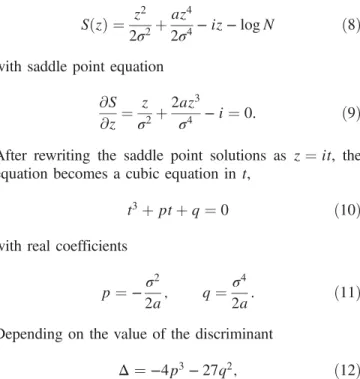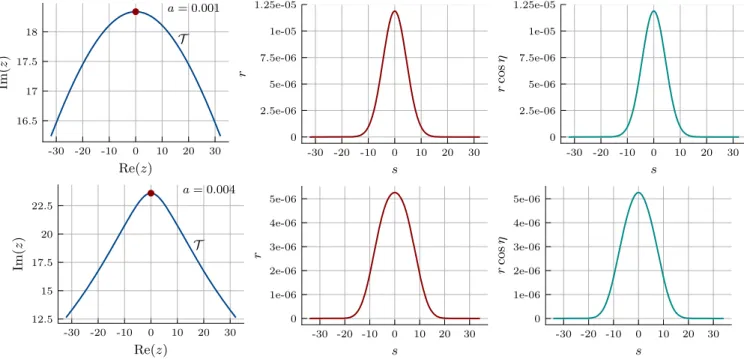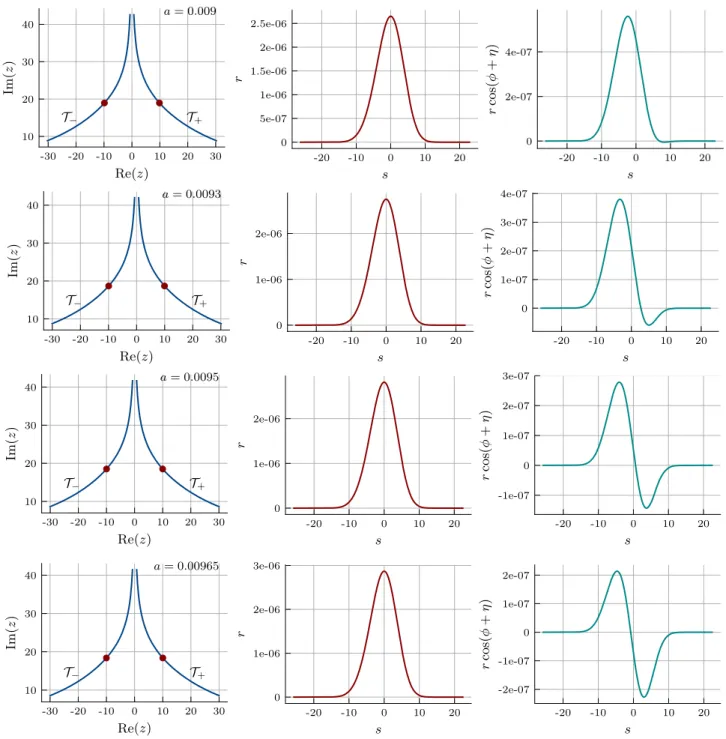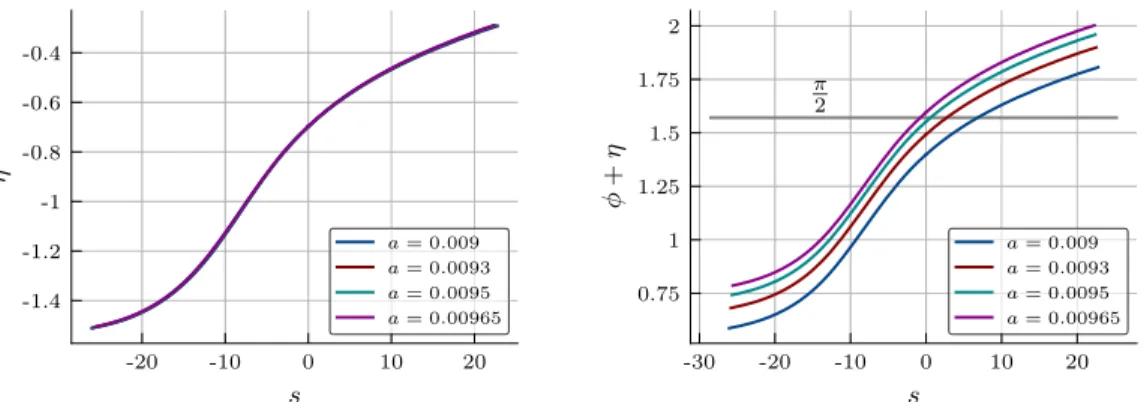Anatomy of a strong residual sign problem on the thimbles
Jacques Bloch
*Institute for Theoretical Physics, University of Regensburg, 93040 Regensburg, Germany
(Received 10 August 2018; published 6 December 2018)
Using a simple Gaussian-like Ansatz for the phase distribution of a theory with a complex action, we show how the thimble integration for the average phase factor can be plagued by a strong residual sign problem when the phase of the complex integration measure conspires with the constant phase of the integrand along the thimble. This strong sign problem prohibits the accurate computation of the average phase factor when it becomes exponentially small, and causes a strong sensitivity to the parameters describing the phase distribution.
DOI:10.1103/PhysRevD.98.114502
I. INTRODUCTION
In lattice simulations of quantum chromodynamics (QCD) at nonzero chemical potential the action in the partition function is generically complex such that standard importance sampling Monte Carlo methods are unusable.
One way to circumvent this problem is to apply the well known density of states method to this particular setting by splitting the complex action in its real and imaginary parts, and considering the density of the phase of the complex weights in the partition function generated by their magnitudes [1].
To apply the density of states method, the phase density pðθÞ is measured explicitly in the phase quenched ensem- ble, and then integrated over to compute the average phase factor
he
iθi ¼ Z
dθpðθÞe
iθ: ð 1 Þ
This can then be used to access thermodynamical observ- ables [2] as the full and phase quenched partition function are related by Z
full¼ he
iθiZ
pq. It is well known that for growing chemical potential, he
iθi is exponentially small in the volume of the simulated system, and its computation is plagued by a strong sign problem [3]. If he
iθi is computed from the oscillatory integral (1), its accurate determination requires a very precise knowledge of the phase distribution pðθÞ , which might be obtained with the logarithmic linear relaxation (LLR) algorithm [4]. To further improve the
accuracy and stability of the integration, a judicious fit to the measured phase distribution is performed before inte- grating the phase factor [2].
Herein we present a simple example illustrating that the average phase factor obtained from such a fit is neither necessarily stable under slight variations of the fit param- eters, nor can it be computed accurately when the sign problem becomes too strong. To compute this oscillatory integral we opted to use the thimble integration, which is often believed to reduce the sign problem and make it manageable. One of our motivations was to investigate the mechanism by which the thimble integration yields expo- nentially small values for he
iθi .
When integrating along a thimble, the magnitude of the complex integrand falls off in a Gaussian like manner at either side of the saddle point. Nevertheless, there is a potential sign problem due to the residual phase along the thimble, which is caused by the phase of the complex measure along the integration path and the constant phase of the integrand on the thimble. Even though it is often claimed in the literature that the sign problem caused by this residual phase is most probably negligible [5,6], this is not true for the simple, physically motivated example discussed in this paper, as the phase of the complex measure can conspire with the constant nonzero phase of the integrand along the thimble to cause a sign problem that can even be maximally strong for physically relevant parameter values.
Although we applied the thimble integration to the one- dimensional oscillatory integral (1) occurring in the density of states method, the knowledge about the residual sign problem could have a wider scope as the Lefschetz thimbles, which are paths of steepest descent, are also intensively being explored to resolve the sign problem in the high dimensional integration occurring in the partition function of lattice QCD and other quantum field theories at nonzero chemical potential [5,7 – 11]. The application of the
*
jacques.bloch@ur.de
Published by the American Physical Society under the terms of the Creative Commons Attribution 4.0 International license.
Further distribution of this work must maintain attribution to
the author(s) and the published article ’ s title, journal citation,
and DOI. Funded by SCOAP
3.
thimble method to these high dimensional systems is very tedious [12 – 14] and more recently promising alternatives like the generalized thimbles [13,15 – 18] and the path optimization technique [19,20] were proposed to deform the integration path in an optimal way. Nevertheless, there are reports of a global sign problem, due to cancellations between thimbles with different constant phases, in studies of phase transitions and the Silver Blaze phenomenon [12,21].
In Sec. II we will describe the choice of the phase distribution pðθÞ in (1). In Sec. III we will introduce the basic elements needed to perform the thimble integration, and in Sec. IV we will give the results and discuss the residual sign problem. Finally, we close with some con- clusions in Sec. V .
II. PHASE DISTRIBUTION
In lattice simulations of QCD at nonzero chemical potential the weights in the partition function are generi- cally complex due to the fermion determinant. The dis- tribution pðθÞ represents the probability density of the phase of these complex weights in the phase quenched ensemble [1], which is generated with the magnitude of the complex weights.
As θ is a complex phase it would be natural to assume θ ∈ ð−π; þπ. When the sign problem is large, the dis- tribution nears a uniform distribution over this interval, and the exponentially small value for he
iθi arises from tiny corrections to this uniform distribution, which cannot be determined accurately enough to allow for a useful deter- mination of he
iθi .
To improve upon this, it was suggested to consider an extensive phase, which is defined such that θ is no longer bounded and branch cut discontinuities are avoided [22,23]. Claim is that as the physical volume of the system gets larger, the distribution of the extended phase converges to a Gaussian distribution such that a pure Gaussian Ansatz would suffice to compute he
iθi and perform phenomenol- ogy at nonzero density [22 – 27]. The argumentation also involves the cumulant expansion for he
iθi, which, if it converges, is always real and positive, and whose leading term corresponds to the Gaussian result.
The Gaussian Ansatz was however questioned by the observation that higher order corrections in the cumulant expansion, which involve delicate volume cancellations, could invalidate the Gaussian value of he
iθi [28–30]. The simple example presented below is very much supporting the latter argument, as we found that the cumulant expansion converges extremely slowly for the simple Gaussian-like distribution (2) when the sign problem becomes strong, and that higher order terms can indeed make he
iθi orders of magnitudes smaller than its naive Gaussian value. The detailed discussion of the convergence of the cumulant expansion will be discussed
elsewhere [31], as we will presently focus on the analysis of the thimble integration.
The distribution pðθÞ of the extended phase is generi- cally described by an exponential of an even polynomial in θ , as is discussed in the context of Monte Carlo simulations of QCD at finite density [2,29,30]. Herein we will consider the simplest extension of the Gaussian distribution within that framework, namely an exponential of a quartic polynomial,
pðθÞ ¼ N exp
− θ
22σ
21 þ a θ
2σ
2ð2Þ
with normalization factor N ¼ 2 ffiffiffi p a
=ðσe
κK
1=4ðκÞÞ , where κ ¼ 1=ð16aÞ , K
1=4is a modified Bessel function of frac- tional order, and a ≥ 0 .
This particular functional form for pðθÞ is also suggested by detailed studies of the phase distribution in Monte Carlo simulations of a random matrix theory (RMT) that models some important properties of QCD at nonzero chemical potential [32,33] and which will be reported elsewhere [31]. The quartic term is dictated by the tails of the measured phase distributions, which are slightly narrower than those of a normal distribution. The parameters σ and a can unambiguously be extracted from the second and fourth moments of the phase distribution measured in the Monte Carlo simulations.
Although the analysis performed in this paper is valid for any value of σ in (2), the results will all be given for σ ¼ 4.2. We will investigate the behavior of he
iθi for small values of a , where the distribution is very close to normal.
This choice of parameter values stems from the RMT simulations for matrix sizes where the sign problem is strong [31].
1The phase distribution (2) is illustrated in Fig. 1 for σ ¼ 4 . 2 and a ¼ 0 . 0095 . For such small a the distribution is almost undistinguishable from a Gaussian, as can be seen in the figure. In Fig. 2 we show the real part of the oscillating integrand in (1) obtained for this distribution.
Although the main focus of this paper will be the computation of (1) using Lefschetz thimbles, in particular in the region where the sign problem is strong, we can also compute this one-dimensional integral using standard numerical quadrature routines, as long as the sign problem remains amenable to such methods. The results for he
iθi as a function of a are presented in Fig. 3 for σ ¼ 4 . 2 . When a ¼ 0 we recover the Gaussian result, where the average phase factor can be computed analytically,
1
Note that similar actions were considered in a one-
dimensional model [34] and in ϕ
4field theory [6,7,35]. However,
there is no residual sign problem in these studies because the ratio
of the quartic to the Gaussian term in the action is of Oð1Þ , while
it is <10
−3in our case.
he
iθi
Gauss¼ e
−σ2=2: ð 3 Þ
As a increases, the average phase factor decreases and has a zero crossing at a
0≈ 0 . 00965632 . The region a ∈ ½0; a
0Þ is especially important in the context of physical simulations with a complex action as he
iθi is known to be positive but exponentially small in the volume. In the remainder of this paper we will investigate how such small values can arise in the thimble framework.
III. THIMBLE ANALYSIS
In the thimble formulation [36], the original integral (1) is rewritten as
he
iθi ¼ Z
dθpðθÞe
iθ¼ X
T∈Ω
I
T; ð 4 Þ
where Ω is the set of relevant thimbles in the complex plane that contribute to the integral. Thimbles are trajectories of constant phase going through saddle points of the inte- grand. The integral on a thimble T is
I
T¼ Z
T
dzfðzÞ ¼ Z
T
dsfðzðsÞÞ dz
ds ; ð 5 Þ where we changed notation from θ to z , to emphasize that the variable has been complexified, and parametrized the thimble by its arc length s . The complex measure along the thimble can be rewritten as dz ¼ dse
iηðsÞ, such that
I
T¼ Z
T
dsfðzðsÞÞe
iηðsÞ: ð 6 Þ
The phase factor e
iηðsÞis the Jacobian of the arc length parametrization of the thimble, where ηðsÞ is the angle of the tangential to the thimble.
As thimbles are trajectories of constant phase ϕ , we can write fðzðsÞÞ ¼ rðsÞe
iϕwith rðsÞ ¼ jfðzðsÞÞj such that
I
T¼ Z
T




